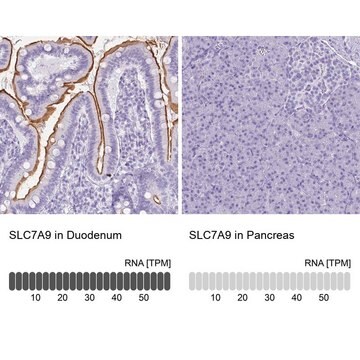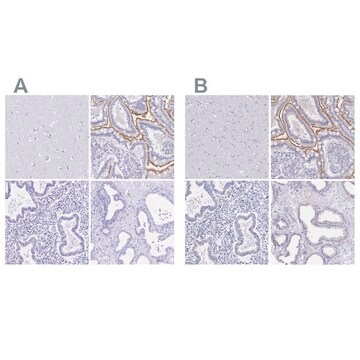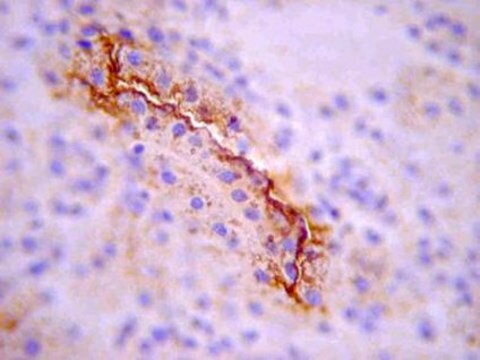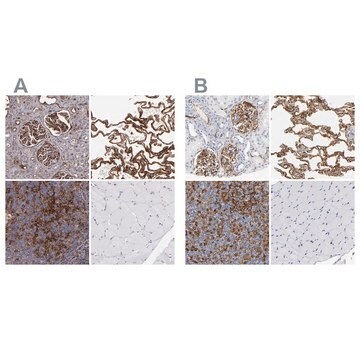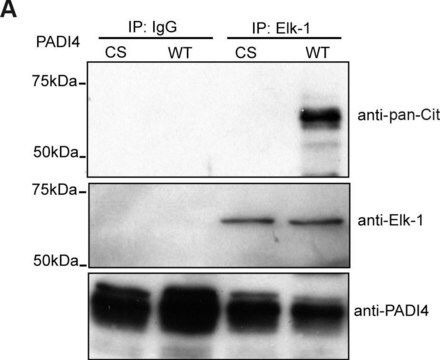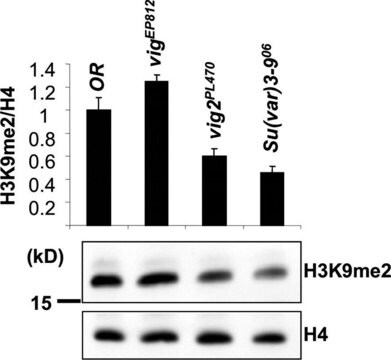詳細
ZooMAb® antibodies represent an entirely new generation of recombinant monoclonal antibodies. Each ZooMAb® antibody is manufactured using our proprietary recombinant expression system, purified to homogeneity, and precisely dispensed to produce robust and highly reproducible lot-to-lot consistency. Only top-performing clones are released for use by researchers. Each antibody is validated for high specificity and affinity across multiple applications, including its most commonly used application. ZooMAb® antibodies are reliably available and ready to ship when you need them.
特異性
Clone 1K16 is a ZooMAb® rabbit recombinant monoclonal antibody that specifically detects Sodium/glucose cotransporter 1 (SGLT-1). It targets an epitope within 19 amino acids from the C-terminal half.
免疫原
KLH-conjugated linear peptide corresponding to 19 amino acids from the C-terminal half of human Sodium/glucose cotransporter 1 (SGLT-1).
アプリケーション
Quality Control Testing
Evaluated by Western Blotting in HepG2 cell lysate.
Western Blotting Analysis: A 1:1,000 dilution of this antibody detected SGLT-1 in HepG2 cell lysate.
Tested Applications
Western Blotting Analysis: A 1:1,000 dilution from a representative lot detected SGLT-1 in C6 cell lysates.
Affinity Binding Assay: A representative lot of this antibody bound SGLT-1 peptide with a KD of 9.5 x 10-7 in an affinity binding assay.
Immunofluorescence Analysis: A 1:1,000 dilution from a representative lot detected SGLT-1 in Human small intestine tissue sections.
Immunohistochemistry (Paraffin) Analysis: A 1:1,000 dilution from a representative lot detected SGLT-1 in Human small intestine tissue sections.
Note: Actual optimal working dilutions must be determined by end user as specimens, and experimental conditions may vary with the end user.
ターゲットの説明
Sodium/glucose cotransporter 1 (UniProt: P13866; also known as Na(+)/glucose cotransporter 1, High affinity sodium-glucose cotransporter, Solute carrier family 5 member 1) is encoded by the SLC5A1 (also known as NAGT, SGLT1) gene (Gene ID: 6523) in human. SGLT-1 is a multi-pass membrane protein with eight extracellular domains, fourteen transmembrane domains, and six cytoplasmic domains. Its expression is observed in intestine and endometrial cells. It serves as an electrogenic Na+-coupled sugar simporter that actively transports D-glucose or D-galactose at the plasma membrane, with a Na+ to sugar coupling ratio of 2:1. Its transporter activity is driven by a transmembrane Na+ electrochemical gradient set by the Na+/K+ pump. Its primary role is in the transport of dietary monosaccharides from enterocytes to blood and it is also responsible for the absorption of D-glucose or D-galactose across the apical brush-border membrane of enterocytes. It also functions as a D-glucose sensor in enteroendocrine cells, triggering the secretion of the incretins GCG and GIP that control food intake and energy homeostasis. Along with SGLT-2, it also functions in reabsorption of D-glucose from glomerular filtrate, playing a non-redundant role in the S3 segment of the proximal tubules. In endometrials cells it transports D-glucose and controls glycogen synthesis and nutritional support for the embryo as well as the decidual transformation of endometrium prior to conception. Mutations in SLC5A1 gene cause congenital glucose/galactose malabsorption, an autosomal recessive disorder that is characterized by severe diarrhea and dehydration. Two isoforms of SGLT-1 have been described that are produced by alternative splicing. This ZooMAb® recombinant monoclonal antibody, generated by our propriety technology, offers significantly enhanced specificity, affinity, reproducibility, and stability over conventional monoclonals. (Ref.: Salker, MS., et al. (2017). Sci. Rep. 7(1); 12612; Hummel, CS., et al. (2011). Am. J. Physiol. Cell Physiol. 300(1); C14-C21; Martin, MG., et al. (1996). Nat. Genet. 12(2); 216-220).
物理的形状
Purified recombinant rabbit monoclonal antibody IgG, lyophilized in PBS with 5% Trehalose, normal appearance a coarse or translucent resin. The PBS/trehalose components in the ZooMAb formulation can have the appearance of a semi-solid (bead like gel) after lyophilization. This is a normal phenomenon. Please follow the recommended reconstitution procedure in the data sheet to dissolve the semi-solid, bead-like, gel-appearing material. The resulting antibody solution is completely stable and functional as proven by full functional testing. Contains no biocide or preservatives, such as azide, or any animal by-products. Larger pack sizes provided as multiples of 25 µL.
再構成
300 µg/mL after reconstitution at 25 µL per vial. Please refer to guidance on suggested starting dilutions and/or titers per application and sample type.
保管および安定性
Recommend storage of lyophilized product at 2-8°C; Before reconstitution, micro-centrifuge vials briefly to spin down material to bottom of the vial; Reconstitute each vial by adding 25 µL of filtered lab grade water or PBS; Reconstituted antibodies can be stored at 2-8°C, or -20°C for long term storage. Avoid repeated freeze-thaws.
法的情報
ZooMAb is a registered trademark of Merck KGaA, Darmstadt, Germany
免責事項
Unless otherwise stated in our catalog or other company documentation accompanying the product(s), our products are intended for research use only and are not to be used for any other purpose, which includes but is not limited to, unauthorized commercial uses, in vitro diagnostic uses, ex vivo or in vivo therapeutic uses or any type of consumption or application to humans or animals.

